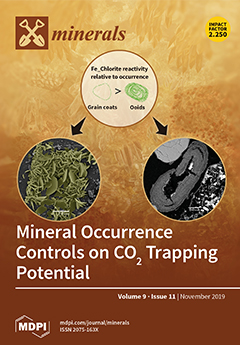Nataliakulikite, Ca
4Ti
2(Fe
3+,Fe
2+)(Si,Fe
3+,Al)O
11, is a mineral intermediate between perovskite CaTiO
3 and brownmillerite Ca
2(Fe,Al)
2O
5. It was discovered as a minor mineral in a high-temperature pyrometamorphic larnite-gehlenite rock at the Nahal Morag Canyon of the Hatrurim Basin, Israel. Nataliakulikite is associated with larnite, flamite, gehlenite, magnesioferrite, Fe
3+-rich perovskite, fluorapatite, barite, Hashemite, and retrograde phases (afwillite, hillebrandite, portlandite, calcite, ettringite, hydrogarnet, and other hydrated Ca-silicates). The mineral forms brown subhedral or prismatic grains (up to 20 µm) and their intergrowths (up to 50 μm). Its empirical formula (
n = 47) is (Ca
3.992Sr
0.014U
0.004)(Ti
1.933Zr
0.030Nb
0.002) (Fe
3+0.610Fe
2+0.405Cr
0.005Mn
0.005)(Si
0.447Fe
3+0.337Al
0.216)O
11 and shows Si predominance in tetrahedral site. The unit-cell parameters (HRTEM data) and space group are:
a = 5.254,
b = 30.302,
c = 5.488 Å,
V = 873.7 Å
3,
Pnma,
Z = 4. These dimensions and Electron backscatter diffraction (EBSD) data strongly support the structural identity between nataliakulikite and synthetic Ca
4Ti
2Fe
3+2O
11 (2CaTiO
3∙Ca
2Fe
3+2O
5), an intermediate compound in the system CaTiO
3-Ca
2Fe
3+2O
5. In general, this mineral is a Si-Fe
2+-rich natural analog of synthetic Ca
4Ti
2Fe
3+2O
11. The X-ray powder diffraction data (Cu
Kα -radiation), calculated from unit-cell dimensions, show the strongest lines {
d [Å], (
Icalc)} at: 2.681(100), 1.898(30), 2.627(26), 2.744(23), 1.894(22), 15.151(19), 1.572(14), 3.795(8). The calculated density is 4.006 g/cm
3. The crystal structure of nataliakulikite has not been refined because of small sizes of grains. The Raman spectrum shows strong bands at 128, 223, 274, 562, and 790 cm
−1. Nataliakulikite from the Hatrurim Basin crystallized under the conditions of combustion metamorphism at high temperatures (1160–1200 °C) and low pressures (HT-region of the spurrite-merwinite facies).
Full article





